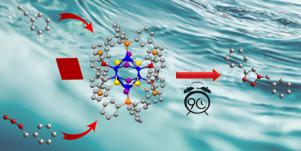Molecular Catalysis ( IF 3.9 ) Pub Date : 2022-04-21 , DOI: 10.1016/j.mcat.2022.112290 Saeedeh Asadizadeh 1 , Marzieh Sohrabi 1 , Kurt Mereiter 2 , Hossein Farrokhpour 1 , Soraia Meghdadi 1 , Mehdi Amirnasr 1

|
Thiol/disulfide interconversion, catalyzed by metal ions and enzymes, is a fundamental transformation and plays important roles in biological systems. The thiolates, produced in these reactions, are particularly versatile sulfur-containing ligands that can bind to metals or group of metals via a variety of modes and this versatility can lead to the formation of polymeric chains and metal clusters with high nuclearity. Herein, we report the facile one pot synthesis of novel octanuclear copper(I) complexes, [Cu8{(N)-(μ4-S)}4(μ3-I)2I2(PPh3)2] (1–5), by the reaction of copper(I) iodide and disulfide Schiff base molecules (R-CH N˗Ph˗S˗S˗Ph-N
N˗Ph˗S˗S˗Ph-N CH-R, RMePh = 4-MePh (SB1), RMeOPh = 4-MeOPh (SB2), RMeSPh = 4-MeSPh (SB3), RBrPh = 4-BrPh (SB4), and RFur = 2-furan (SB5)) in the presence of PPh3 in dichloromethane-acetonitrile or chloroform-acetonitrile solution under ambient conditions. Single-crystal X-ray structure analyses of these clusters confirm the presence of Cu8S4I4 core stabilized by the chelating Schiff base thiolate fragment R-CH
CH-R, RMePh = 4-MePh (SB1), RMeOPh = 4-MeOPh (SB2), RMeSPh = 4-MeSPh (SB3), RBrPh = 4-BrPh (SB4), and RFur = 2-furan (SB5)) in the presence of PPh3 in dichloromethane-acetonitrile or chloroform-acetonitrile solution under ambient conditions. Single-crystal X-ray structure analyses of these clusters confirm the presence of Cu8S4I4 core stabilized by the chelating Schiff base thiolate fragment R-CH N˗Ph˗Sˉ produced by the reductive cleavage of disulfide bond, Iˉ, and PPh3. DFT calculations have been performed to describe a speculative mechanism of cluster formation. The octanuclear clusters [Cu8{(N)-(μ4-S)}4(μ3-I)2I2(PPh3)2] (1–5) have been exploited as efficient heterogeneous catalysts for the green synthesis of 1,2,3-triazoles from NaN3, alkyl halides, and alkyne derivatives (CuAAC reaction) under mild conditions.
N˗Ph˗Sˉ produced by the reductive cleavage of disulfide bond, Iˉ, and PPh3. DFT calculations have been performed to describe a speculative mechanism of cluster formation. The octanuclear clusters [Cu8{(N)-(μ4-S)}4(μ3-I)2I2(PPh3)2] (1–5) have been exploited as efficient heterogeneous catalysts for the green synthesis of 1,2,3-triazoles from NaN3, alkyl halides, and alkyne derivatives (CuAAC reaction) under mild conditions.
中文翻译:

新型八核铜 (I) 簇 [Cu8{(N)-(μ4-S)}4(μ3-I)2I2(PPh3)2] 通过二硫化物席夫碱配体的还原 SS 键断裂产生及其作为高效多相催化剂的用途在 CuAAC 点击反应
由金属离子和酶催化的硫醇/二硫化物相互转化是一种基本的转化,在生物系统中发挥着重要作用。在这些反应中产生的硫醇盐是特别通用的含硫配体,可以通过多种模式与金属或金属基团结合,这种多功能性可以导致形成具有高核度的聚合物链和金属簇。在此,我们报道了新型八核铜(I)配合物的简便一锅法合成[Cu 8 {(N)-(μ 4 -S)} 4 (μ 3 -I) 2 I 2 (PPh 3 ) 2 ] ( 1 – 5), 通过碘化铜 (I) 和二硫化物席夫碱分子的反应 (R-CH  N˗Ph˗S˗S˗Ph-N
N˗Ph˗S˗S˗Ph-N  CH-R, R MePh = 4-MePh (SB 1 ), R MeOPh = 4 -MeOPh (SB 2 )、R MeSPh = 4-MeSPh (SB 3 )、R BrPh = 4-BrPh (SB 4 ) 和 R Fur = 2-呋喃 (SB 5 )),在二氯甲烷中存在 PPh 3-环境条件下的乙腈或氯仿-乙腈溶液。这些簇的单晶 X 射线结构分析证实了 Cu 8 S 4 I 4的存在
CH-R, R MePh = 4-MePh (SB 1 ), R MeOPh = 4 -MeOPh (SB 2 )、R MeSPh = 4-MeSPh (SB 3 )、R BrPh = 4-BrPh (SB 4 ) 和 R Fur = 2-呋喃 (SB 5 )),在二氯甲烷中存在 PPh 3-环境条件下的乙腈或氯仿-乙腈溶液。这些簇的单晶 X 射线结构分析证实了 Cu 8 S 4 I 4的存在 通过二硫键、Iˉ和PPh 3的还原裂解产生的螯合席夫碱硫醇盐片段R-CH N˗Ph˗Sˉ稳定核心。已经执行 DFT 计算来描述集群形成的推测机制。八核簇 [Cu 8 {(N)-(μ 4 -S)} 4 (μ 3 -I) 2 I 2 (PPh 3 ) 2 ] ( 1 – 5 ) 已被用作绿色合成的高效多相催化剂在温和条件下由 NaN 3、卤代烷和炔烃衍生物(CuAAC 反应)制备 1,2,3-三唑。
通过二硫键、Iˉ和PPh 3的还原裂解产生的螯合席夫碱硫醇盐片段R-CH N˗Ph˗Sˉ稳定核心。已经执行 DFT 计算来描述集群形成的推测机制。八核簇 [Cu 8 {(N)-(μ 4 -S)} 4 (μ 3 -I) 2 I 2 (PPh 3 ) 2 ] ( 1 – 5 ) 已被用作绿色合成的高效多相催化剂在温和条件下由 NaN 3、卤代烷和炔烃衍生物(CuAAC 反应)制备 1,2,3-三唑。


















































 京公网安备 11010802027423号
京公网安备 11010802027423号